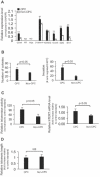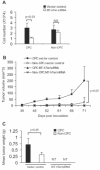Prostate tumor cells with cancer progenitor properties have high telomerase activity and are rapidly killed by telomerase interference
- PMID: 21321978
- PMCID: PMC3123672
- DOI: 10.1002/pros.21355
Prostate tumor cells with cancer progenitor properties have high telomerase activity and are rapidly killed by telomerase interference
Abstract
Background: Cancer progenitor cells (CPCs) have been postulated to promote treatment resistance and disease progression in prostate and other malignancies. We investigated whether the enzyme telomerase, which is active in cancer cells and in normal stem cells, plays an important role in CPC which can be exploited to neutralize these cells.
Methods: We used flow cytometry and assays of gene expression, clonogenicity, and invasiveness to isolate and characterize a putative CPC subpopulation from freshly resected human prostatectomy specimens. Telomerase activity was measured by qPCR-based Telomeric Repeat Amplification Protocol (TRAP). Telomerase interference was achieved by ectopic expression of a mutated telomerase RNA construct which reprograms telomerase to generate "toxic" uncapped telomeres. Treated cells were assayed for apoptosis, proliferation in culture, and xenograft tumor formation.
Results: CPC in prostate tumors expressed elevated levels of genes associated with a progenitor phenotype and were highly clonogenic and invasive. Significantly, CPC telomerase activity was 20- to 200-fold higher than in non-CPC from the same tumors, and CPC were exquisitely sensitive to telomerase interference which induced rapid apoptosis and growth inhibition. Similarly, induction of telomerase interference in highly tumorigenic CPC isolated from a prostate cancer cell line abrogated their ability to form tumor xenografts.
Conclusions: Human prostate tumors contain a CPC subpopulation with markedly elevated telomerase activity which renders them acutely susceptible to telomerase interference. These findings offer the first tumor-derived and in vivo evidence that telomerase may constitute a CPC "Achilles heel" which may ultimately form the basis for more effective new CPC-targeting therapies.
Copyright © 2011 Wiley-Liss, Inc.
Figures





Similar articles
-
Relative contribution of normal and neoplastic cells determines telomerase activity and telomere length in primary cancers of the prostate, colon, and sarcoma.Clin Cancer Res. 1997 Oct;3(10):1849-57. Clin Cancer Res. 1997. PMID: 9815573
-
The effects of telomerase inhibition on prostate tumor-initiating cells.Int J Cancer. 2010 Jul 15;127(2):321-31. doi: 10.1002/ijc.25043. Int J Cancer. 2010. PMID: 19908230
-
Prostate tumor-initiating cells: a new target for telomerase inhibition therapy?Biochim Biophys Acta. 2009 Apr;1792(4):289-96. doi: 10.1016/j.bbadis.2009.02.012. Epub 2009 Mar 2. Biochim Biophys Acta. 2009. PMID: 19264126 Review.
-
Inhibition of telomerase activity by dominant-negative hTERT retards the growth of breast cancer cells.Breast Cancer. 2016 Mar;23(2):216-23. doi: 10.1007/s12282-014-0553-z. Epub 2014 Aug 7. Breast Cancer. 2016. PMID: 25098685
-
Prostate cancer stem cells, telomerase biology, epigenetic modifiers, and molecular systemic therapy for the androgen-independent lethal phenotype.Urol Oncol. 2006 Mar-Apr;24(2):119-21. doi: 10.1016/j.urolonc.2005.11.031. Urol Oncol. 2006. PMID: 16520275 Review.
Cited by
-
AXIN2 expression predicts prostate cancer recurrence and regulates invasion and tumor growth.Prostate. 2016 May;76(6):597-608. doi: 10.1002/pros.23151. Epub 2016 Jan 15. Prostate. 2016. PMID: 26771938 Free PMC article.
-
Telomeres and telomerase in prostate cancer development and therapy.Nat Rev Urol. 2017 Oct;14(10):607-619. doi: 10.1038/nrurol.2017.104. Epub 2017 Jul 4. Nat Rev Urol. 2017. PMID: 28675175 Free PMC article. Review.
-
Telomere and Telomerase Therapeutics in Cancer.Genes (Basel). 2016 May 26;7(6):22. doi: 10.3390/genes7060022. Genes (Basel). 2016. PMID: 27240403 Free PMC article. Review.
-
Role of prostate cancer stem-like cells in the development of antiandrogen resistance.Cancer Drug Resist. 2022 Jun 1;5(2):459-471. doi: 10.20517/cdr.2022.07. eCollection 2022. Cancer Drug Resist. 2022. PMID: 35800367 Free PMC article. Review.
-
A second chance for telomerase reverse transcriptase in anticancer immunotherapy.Nat Rev Clin Oncol. 2017 Feb;14(2):115-128. doi: 10.1038/nrclinonc.2016.67. Epub 2016 Jun 1. Nat Rev Clin Oncol. 2017. PMID: 27245281 Review.
References
-
- Gupta PB, Chaffer CL, Weinberg RA. Cancer stem cells: mirage or reality? Nat Med. 2009;15(9):1010–1012. - PubMed
-
- Visvader JE, Lindeman GJ. Cancer stem cells in solid tumours: accumulating evidence and unresolved questions. Nat Rev Cancer. 2008;8(10):755–768. - PubMed
-
- Collins AT, Habib FK, Maitland NJ, Neal DE. Identification and isolation of human prostate epithelial stem cells based on alpha(2)beta(1)-integrin expression. J Cell Sci. 2001;114(Pt 21):3865–3872. - PubMed
-
- Collins AT, Berry PA, Hyde C, Stower MJ, Maitland NJ. Prospective identification of tumorigenic prostate cancer stem cells. Cancer Res. 2005;65(23):10946–10951. - PubMed
Publication types
MeSH terms
Substances
Grants and funding
LinkOut - more resources
Full Text Sources
Medical
Miscellaneous

